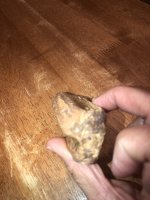kenb
Bronze Member
What In The World Is A Gungywamp?
By MARLENE CLARK
Febr
Gungywamp is a 100-acre area in Groton that archaeologists consider a treasure. Its exact origins remain a mystery, but its unusual stonework and artifacts span centuries, if not eons.
Among Gungywamp's features are stone chambers that researchers believe were Colonial-era root cellars or animal birthing shelters erected by English-Scottish immigrants. Of these, two are intact. One contains a solar calendar: during the spring and autumn equinox, the sun shines through an opening in the west wall and lights the opposite wall, which reflects some light into a smaller, interior, beehive-shaped chamber. Solar timetables helped farmers decide when to plant and harvest crops or avoid crop freeze in the winter and crop rot in the summer. Archaeologists have found no evidence to support the popular theory that medieval Celtic monks built the chambers. Still, the lack of artifacts in the chambers leaves room for speculation.
North of the chambers are two sets of double concentric circles comprising 21 large quarried stones laid end to end. The circles, about 11 feet in diameter, were most likely part of tanning mills.
Gungywamp's southeastern area contains two disjointed rows of standing stones set in sockets of smaller stones. A bird is carved into one of the stones. Some researchers believe the stones are the remains of a stone wall, but others won't commit to any theory. And no one knows who may have carved the bird, or why.
Near the disjointed structure are stone bridges and various rounded stones atop boulders. This may have been a drainage system for water runoff, or Native Americans could have used them to entrap animals. Some stones also contain carved letters that may have been surveyor or boundary marks.
Archaeologists have unearthed pottery shards and crude stone flakes used to make arrowheads dating from 2000 B.C. to 700 B.C.
Some say ancient Native Americans used the area and built the structures for religious ceremonies prior to the Colonial era.
Researchers have associated the name, "Gungywamp," with ancient Gaelic, Mohegan, Pequot, and Algonquin terms meaning "church of the people"; "place of ledges"; "swampy place"; or "all powerful" and "white," respectively. Or it could be a corruption of the phrase, "spongy swamp."
Gungywamp is all on private property.
Researchers include members of the Gungywamp Society, an education and research group dedicated to preserving Gungywamp and other archaeological sites in Connecticut.
Information also is available at www.gungywamp.com and at www.stonestructures.org/html/gun gywamp.html.
kenb
By MARLENE CLARK
Febr
Gungywamp is a 100-acre area in Groton that archaeologists consider a treasure. Its exact origins remain a mystery, but its unusual stonework and artifacts span centuries, if not eons.
Among Gungywamp's features are stone chambers that researchers believe were Colonial-era root cellars or animal birthing shelters erected by English-Scottish immigrants. Of these, two are intact. One contains a solar calendar: during the spring and autumn equinox, the sun shines through an opening in the west wall and lights the opposite wall, which reflects some light into a smaller, interior, beehive-shaped chamber. Solar timetables helped farmers decide when to plant and harvest crops or avoid crop freeze in the winter and crop rot in the summer. Archaeologists have found no evidence to support the popular theory that medieval Celtic monks built the chambers. Still, the lack of artifacts in the chambers leaves room for speculation.
North of the chambers are two sets of double concentric circles comprising 21 large quarried stones laid end to end. The circles, about 11 feet in diameter, were most likely part of tanning mills.
Gungywamp's southeastern area contains two disjointed rows of standing stones set in sockets of smaller stones. A bird is carved into one of the stones. Some researchers believe the stones are the remains of a stone wall, but others won't commit to any theory. And no one knows who may have carved the bird, or why.
Near the disjointed structure are stone bridges and various rounded stones atop boulders. This may have been a drainage system for water runoff, or Native Americans could have used them to entrap animals. Some stones also contain carved letters that may have been surveyor or boundary marks.
Archaeologists have unearthed pottery shards and crude stone flakes used to make arrowheads dating from 2000 B.C. to 700 B.C.
Some say ancient Native Americans used the area and built the structures for religious ceremonies prior to the Colonial era.
Researchers have associated the name, "Gungywamp," with ancient Gaelic, Mohegan, Pequot, and Algonquin terms meaning "church of the people"; "place of ledges"; "swampy place"; or "all powerful" and "white," respectively. Or it could be a corruption of the phrase, "spongy swamp."
Gungywamp is all on private property.
Researchers include members of the Gungywamp Society, an education and research group dedicated to preserving Gungywamp and other archaeological sites in Connecticut.
Information also is available at www.gungywamp.com and at www.stonestructures.org/html/gun gywamp.html.
kenb



